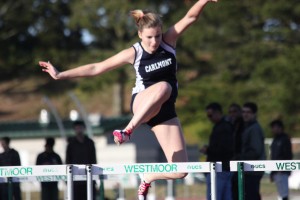[media-credit id=10 align=”aligncenter” width=”300″] [/media-credit]Sports at Carlmont cost a lot of money, but where does all that money come from?
[/media-credit]Sports at Carlmont cost a lot of money, but where does all that money come from?
“[The supplies fund this year] was used to fully or partially to pay for cross country uniforms, football helmets, knee pads, weight belts, flags and caps for water polo, team jackets for volleyball, a new bench for the tennis court, backstroke flags for swimming, bleachers, and lights for the nighttime football games, team basketball bags, cheer team expenses, a timing system for the track team, and ice for the trainer,” said athletic director Patrick Smith.
The Associated Student Body has a team supplies fund used to pay for requests from coaches or teams. This year, the supplies fund at the beginning of the year was $16,250.
Besides the team supplies fund, there are also ASB club accounts and ASB expense accounts.
Teams who do fundraisers or receive donations place the money into the ASB club accounts. This is used by the coaches for equipment and other supplies for the team.
ASB expense accounts are for teams that entail using additional expenses for their games. The balance in the ASB expense accounts differ based on how much the teams require for their games to be played.
Sports that have the ASB expense accounts include football, water polo, volleyball, basketball, soccer, baseball, softball, golf, and swimming.
Carlmont’s sport teams also receive two further sources of funding.
One source was $3,500 that is used by athletic director Patrick Smith’s discretion. This year he decided to use it to buy a new controller for the football scoreboard, used by football, soccer, and lacrosse. He also intends to buy new lane lines for the swimming pool.
The second fund comes from the athletic booster club generous donations. They donated over $45,000 to the athletic teams this year.
The athletic booster club also donated an extra $2,800 for lights for the night football games.
In addition to the funds, athletes are also required to buy certain equipment on their own.
Lacrosse player Simon Pugliano had to pay $350 to the school for a helmet, a jersey, and for bus rides to the games. Furthermore, he had to buy cleats, a lacrosse stick, shoulder pads, gloves, elbow pads, and mouth guards, all which piled up to a very large expense.
“It is very expensive to play lacrosse because you have to buy your own equipment and pay another $350 to play, but it is worth it.” said Pugliano.
Track and field and cross country athlete Mei-Lin Okino is required to buy spikes that usually range from $100 and running shoes that range from $125. She also needs to buy clothing such as shorts, shirts, sweats, and jackets. This year the school provided track and field athletes with jerseys; however, they were still required to buy shorts on their own.
“Initially it is an investment, and it is not as pricey as other sports. Track and cross country are low tech sports, so there is no need to buy equipment in the future,” stated Okino.
Water polo and swimming competitor Nicole Heller had to buy a $60 team suit for swimming, $80 suit for water polo, and additional practice suits that range from $40 to $60. She also had to buy goggles, caps, and fins which, when added up, can reach as much as $70.
“It is expensive to be on the water polo and swimming team, but all sports cost money.” said Heller.
Tennis athlete Byron Wu is required to have one tennis racket that range from $180 to $250; however, he recommends having at least two rackets. In addition, Wu needs to have tennis shoes that are $70, shorts that range from $10 to $20, and a school uniform for $80.
Wu said “I break my strings once every one and a half months, which costs from $20 to $40 to restring, and tennis shoes wear down easily.”
Many other athletes also agree that participating in sports is quite costly.
Soccer player Laura Bowker said that “soccer cleats, which range from $60 to $100, can break easily and sometimes you go through a pair of cleats every season.”
Tennis athlete Tarliyn Won said “it is expensive because actual tennis clothing is very expensive; shirts are $20 to $30.”
However there are some athletes that believe that it doesn’t also need to cost so much.
Badminton player Brent Tom said, “I think that if you are serious in badminton and need to get all the proper stuff it is expensive, but if you are okay with having just one racket, wearing any athletic shoes, and doesn’t need an actual badminton bag, then it’s not that expensive. The only thing that is costly is the uniform.”
Carlmont students continue to dedicate their time and money to sports with the start of the 2012 spring season.
The price of being an athlete
March 19, 2012
Navigate Left
-
 As seen in printAnime popularity and history through time
As seen in printAnime popularity and history through time -
 As seen in printSurviving the war on terror
As seen in printSurviving the war on terror -
 As seen in printSeasoned success
As seen in printSeasoned success -
 As seen in printRideshare companies funnel millions into passing Proposition 22
As seen in printRideshare companies funnel millions into passing Proposition 22 -
 As seen in printDía de los Muertos festival is alive with tradition
As seen in printDía de los Muertos festival is alive with tradition -
 As seen in printGoing with your gut
As seen in printGoing with your gut -
As seen in printThe sibling perspective on autism
-
As seen in printAffirmative Action bill SCA5 turned down for the year
-
As seen in printAthlete of the Month: Rachel Bellin
-
As seen in printAthlete of the Month: Ryan Hogan
Navigate Right
